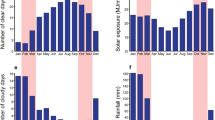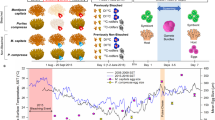Abstract
In colonial modular organisms, differences in module size and colony growth patterns among species have the potential to impose varying constraints on reproductive investment. Here, we compare reproductive output among seven morphologically different species of spawning reef corals, and analyse the relationship between reproductive output and module (polyp) size. Reproductive output ranged between 132 and 384 J cm−2, with lipid constituting the key indicator of energy investment. Lipid decreased by 85–100%, whereas protein and carbohydrate were relatively invariant between pre- and post-spawning tissues in all species, representing 1–15% and <1%, respectively, of the energy investment to reproductive output. The ratio of energy content in reproductive to somatic tissues (gonadosomatic index, GSI) varied among species from 0.20 (Symphyllia recta) to 1.31 (Acropora tenuis), the latter being the highest value reported for any iteroparous marine invertebrate. Surprisingly, small-polyped species (Acropora, Montipora) had 2- to 6-fold higher GSIs than large-polyped ones (Lobophyllia, Symphyllia). Energy equivalents of tissues increased with the 1.50–1.76 power of polyp diameter for somatic tissues and with the 1.42–1.80 power of polyp diameter for reproductive output. In both cases, increases in energy equivalents with polyp diameter were less than the scaling exponent of 3 predicted for an isometric relationship between tissue volume (or mass) and polyp diameter, indicating significant constraints of space, design or physiological energetics with increasing polyp size. We hypothesise that such constraints have played a key role in the evolution of modularity in cnidarians.



Similar content being viewed by others
References
Achituv Y, Ben-Zion M, Mizrahi L (1994) Carbohydrate, lipid, and protein composition of zooxanthellae and animal fractions of the coral Pocillopora damicornis exposed to ammonium enrichment. Pac Sci 48:224–233
Anderson JF (1978) Energy content of spider eggs. Oecologia 37:29–58
Anthony KRN, Fabricius KE (2000) Shifting roles of heterotrophy and autotrophy in coral energetics under varying turbidity. J Exp Mar Biol Ecol 252:221–253
Arai T, Kato M, Heyward A, Ikeda Y, T Iizuka T, Maruyama T (1993) Lipid composition of positively buoyant eggs of reef building corals. Coral Reefs 12:71–75
Babcock RC (1991) Comparative demography of three species of scleractinian corals using age- and size-dependent classifications. Ecol Monogr 61:225–244
Babcock RC, Bull GD, Harrison PL, Heyward AJ, Oliver JK, Wallace CC, Willis BL (1986) Synchronous spawnings of 105 scleractinian coral species on the Great Barrier Reef. Mar Biol 90:379–394
Ben-David-Zaslow R, Benayahu Y (1999) Temporal variation in lipid, protein and carbohydrate content in the Red Sea soft coral Heteroxenia fuscescens. J Mar Biol Assoc UK 79:1001–1006
Calow P (1978) The evolution of life-cycle strategies in freshwater gastropods. Malacologia 17:351–364
Calow P (1979) The cost of reproduction—a physiological approach. Biol Rev 54:23–40
Calow P (1987) Evolutionary physiological ecology. Cambridge University Press, New York
Dubois M, Gilles KA, Hamilton JK, Rebers PA, Smith F (1956) Colorimetric method for determination of sugars and related substances. Anal Chem 28:350–358
Efron B, Tibshirani RJ (1993) An introduction to the bootstrap. Chapman and Hall, New York
Fitt K, Howard JS, Halas J, Michael WW, James WP (1993) Recovery of the coral Montastrea annularis in the Florida Keys after the 1987 Caribbean "bleaching event". Coral Reefs 12:57–64
Folch J, Lees M, Sloane Stanley GH (1957) A simple method for the isolation and purification of total lipids from animal tissues. J Biol Chem 226:497–509
Gnaiger E, Bitterlich G (1984) Proximate biochemical composition and calorific content calculated from elemental CHN analysis: a stochiometric concept. Oecologia 62:289–298
Grime JP (1977) Evidence for the existence of three primary strategies in plants and its relevance to ecological and evolutionary theory. Am Nat 111:1169–1194
Gunderson DR (1997) Trade-off between reproductive effort and adult survival in oviparous and viviparous fishes. Can J Fish Aquat Sci 54:990–998
Hall VR, Hughes TP (1996) Reproductive strategies of modular animals: comparative studies of reef-building corals. Ecology 77:950–963
Harland AD, Fixter LM, Davies PS, Anderson RA (1991) Distribution of lipids between the zooxanthellae and animal compartment in the symbiotic sea anemone Anemonia viridis: wax esters, triglycerides and fatty acids. Mar Biol 110:13–19
Harland AD, Fixter LM, Davies PS, Anderson RA (1992a) Effect of light on the total lipid content and storage lipids of the symbiotic sea anemone Anemonia viridis. Mar Biol 112:253–258
Harland AD, Davies PS, Fixter LM(1992b) Lipid content of some Caribbean corals in relation to depth and light. Mar Biol 113:357–361
Harrison PL, Wallace CC (1990) Reproduction, dispersal, and recruitment of scleractinian corals. In: Dubinsky Z (ed) Ecosystems of the world, coral reefs. Elsevier, Amsterdam, pp 133–207
Harrison PL, Babcock RC, Bull GD, OliverJK, Wallace CC, Willis BL (1984) Mass spawning in tropical reef corals. Science 223:1186–1189
Highsmith RC (1982) Reproduction by fragmentation in corals. Mar Ecol Prog Ser 7:207–226
Hughes TP, Connell J, Ayre D (1992) The evolutionary ecology of corals. Trends Ecol Evol 7:292–295
Lang JC, Chornesky EA (1990) Competition between scleractinian reef corals: a review of mechanisms and effects. In: Dubinsky Z (ed) Ecosystems of the world, coral reefs. Elsevier, Amsterdam, pp 209–252
Maltby L (1999) Studying stress: the importance of organism-level responses. Ecol Appl 9:431–440
Marsh JA (1970) Primary productivity of reef-building calcareous red algae. Ecology 51:255–263
Michaelek-Wagner K, Willis BL (2001) Impacts of bleaching on the soft coral Lobophytum compactum. II. Biochemical changes in adults and their eggs. Coral Reefs 19:240–246
Pearse JS, Pearse VB, Newberry AT (1989) Telling sex from growth: dissolving Maynard-Smith's paradox. Bull Mar Sci 45:433–446
Sakai K (1998) Effect of colony size, polyp size, and budding mode on egg production in a colonial coral. Biol Bull 195:319–325
Schaffer WM (1983) The application of optimal control theory to the general life history problem. Am Nat 121:418–431
Sebens KP (1981) The allometry of feeding, energetics, and body size in three sea anemone species. Biol Bull 161:152–171
Sebens KP (1987) The ecology of indeterminate growth in animals. Annu Rev Ecol Syst 18:371–407
Shine R, Schwarzkopf L (1992) The evolution of reproductive effort in lizards and snakes. Evolution 46:62–75
Stearns SC (1992) The evolution of life histories. Oxford University Press, Oxford
Stimson JS (1987) Location, quantity and rate of change in quantity of lipids in tissue of Hawaiian hermatypic corals. Bull Mar Sci 41:889–904
Stobart B, Babcock RC, Willis BL (1992) Biannual spawning of three species of scleractinian coral from the Great Barrier Reef. Proc 7th Int Coral Reef Symp 1:494–499
Szmant-Froelich A, Pilson MEQ (1980) The Effects of feeding frequency and symbiosis with zooxanthellae on the biochemical composition of Astrangia danae. J Exp Mar Biol Ecol 48:85–98
Van Den Berghe EP (1992) Parental care and the cost of reproduction in a Mediterranean fish. Behav Ecol Sociobiol 30:373–378
Veron JEN (1986) Corals of Australia and the Indo-Pacific, 2nd edn. University of Hawaii Press, Honolulu
Ward S (1995a) Two patterns of energy allocation for growth, reproduction and lipid storage in the scleractinian coral Pocillopora damicornis. Coral Reefs 14:87–90
Ward S (1995b) The effect of damage on the growth, reproduction and storage of lipids in the scleractinian coral Pocillopora damicornis (Linnaeus). J Exp Mar Biol Ecol 187:193–206
Williams GC (1975) Sex and evolution. Princeton University Press, New Jersey
Willis BL, Babcock RC, Harrison PL, Oliver JK, Wallace CC (1985) Patterns in the mass spawning of corals on the Great Barrier Reef from 1981 to 1984. Proceedings of the 5th Int Coral Reef Symposium, pp 343–348
Yamashiro H, Oku H, Higa H, Chinen I, Sakai K (1999) Composition of lipids, fatty acids and sterols in Okinawan corals. Comp Biochem Physiol B. 122:397–407
Acknowledgements
We are grateful to Noel Nevers, Sarah Dalesman and Vincent Riviere for assistance in the field and to the staff of Orpheus Island Research Station. We thank Phil Munday, Julian Caley and Andrew Baird for their critical reading and valuable comments. Two anonymous reviewers provided helpful comments that improved the manuscript. The research was supported by grants from the Australian Research Council to K.R.N.A. (A00105071) and to BLW (A 19933007) and a CRC Reef Research Award to S.L. This is contribution number 74 from the Centre for Coral Reef Biodiversity and number 199 from the Coral Ecology Group at James Cook University.
Author information
Authors and Affiliations
Corresponding author
Rights and permissions
About this article
Cite this article
Leuzinger, S., Anthony, K.R.N. & Willis, B.L. Reproductive energy investment in corals: scaling with module size. Oecologia 136, 524–531 (2003). https://doi.org/10.1007/s00442-003-1305-5
Received:
Accepted:
Published:
Issue Date:
DOI: https://doi.org/10.1007/s00442-003-1305-5




